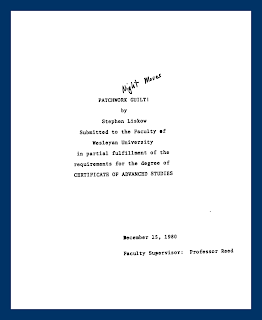I read two mysteries in the past week that I enjoyed very much. One was a cozy, the other sort of a historical (it involved time travel). The juxtaposition of reading them back-to-back brought a writing question to the fore: How do you find the balance between not wanting to spoon-feed the reader key facts and not wanting to leave them confused?
In one of these books, as the sleuth put the clues together and figured out whodunit, she laid out her thought process. Fact A led to fact B, which led to fact C. Consequently, the sleuth knew, Character X was the killer. I reread the section multiple times. I agreed about facts A, B, and C, but how--I wondered--had the sleuth jumped from fact C to knowing whodunit? While I had correctly guessed the killer, I hadn't been sure of why this character had committed murder, and reading this part of the book didn't enlighten me. Ultimately, I realized there was a key fact, D, which hadn't been mentioned while the sleuth was figuring things out. The author had left room for the reader to guess about fact D so the reader could draw her own connections between the facts and the killer's identity.
In the other book, the sleuth not only talked about facts A, B, and C. She talked about facts D, E, F, and G, drilling down, showcasing her thought process. By the time she realized who the killer was, there was no way the reader would have any question how she came to that conclusion. The author had left a roadmap that would have made Rand McNally proud.
 |
| Image by rawpixel.com |
Which author's approach was the right one? Trick question! They both were right. Some authors simply like to give readers more room to draw their own conclusions than others do. There's nothing wrong with either way of doing things.
Of course, not all readers would agree, and that's the rub.
I've read reviews where readers complained about plot holes because the author, like in my first example above, didn't explain how the sleuth came to a certain conclusion. I've also read reviews where readers complained because they didn't like how the author spelled all the details out, as if the author didn't trust the readers to be smart enough to draw their own conclusions.
What's a poor author to do? Seems you're damned if you do and damned if you don't.
The problem is that some readers are more literal than others. They need or want the facts to be spelled out because, without them, these readers won't see how the sleuth reached her conclusions and might think you have a plot hole. These readers don't want to have to work so hard while relaxing with a book.
Other readers are more intuitive and feel patronized if an author explains or (from these readers' perspective) overexplains things. For these readers, part of the fun of a puzzle mystery is being given the room to figure things out for themselves, and when that fun is denied them, they become aggravated.
This isn't to put readers in either group down. I can be pretty literal myself and often encourage clients to explain things a bit more, helping the reader to connect the dots. Yet there certainly are times when I read a book and think, we know, we know, get on with it. Every reader has their own tolerance for how much explanation they like and need. The challenge for authors is to satisfy readers who are more literal-minded while at the same time satisfying readers who enjoy making connections. Satisfy everyone, no matter where they fall on the reading spectrum!
 |
| Image by rawpixel.com |
You're cursing at me under your breath, aren't you? I get it. It's easy to say, not so easy to do. But here's my suggestion for finding that sweet spot: First, figure out what your natural inclination is. Are you more literal-minded or more intuitive? Do you tend to overexplain or underexplain? Then, once you know which way you tend to lean, make sure you have a beta reader or critique partner or editor who leans the other way.
An author whose natural inclination is to assume the reader will make logical jumps would be well served by a more literal-minded editor who can point out where there are gaps in the sleuth's thought process. In contrast, an author whose natural inclination is to spell out every little detail would probably benefit from a reader who is good at making connections and who can highlight where the author explained so much that the writing began to drag. Between the two of you, you hopefully will find a good middle ground so your literal-minded readers won't feel lost, yet your intuitive readers will still feel challenged.
Good luck!












